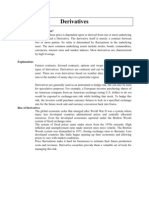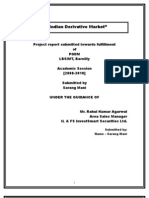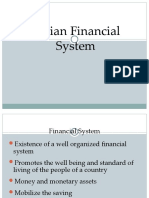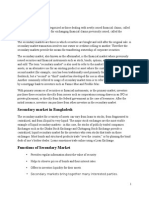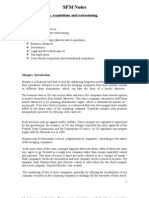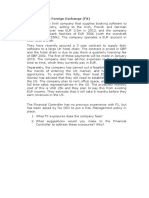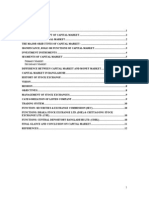0 ratings0% found this document useful (0 votes)
119 viewsSwap
Swap
Uploaded by
Johana ReyesSwaps involve the exchange of cash flows between two counterparties based on predetermined terms. The most common type is an interest rate swap where one party exchanges a fixed interest rate for a floating rate. Swaps allow entities to hedge risks like interest rate risk or speculate on price changes. They were first introduced in 1981 and today total over $426 trillion in notional value, mainly consisting of interest rate and currency swaps. While most swaps are traded over-the-counter, some are exchanged on futures markets. There are also credit default, commodity, currency and various other types of swaps.
Copyright:
© All Rights Reserved
Available Formats
Download as DOCX, PDF, TXT or read online from Scribd
Swap
Swap
Uploaded by
Johana Reyes0 ratings0% found this document useful (0 votes)
119 views3 pagesSwaps involve the exchange of cash flows between two counterparties based on predetermined terms. The most common type is an interest rate swap where one party exchanges a fixed interest rate for a floating rate. Swaps allow entities to hedge risks like interest rate risk or speculate on price changes. They were first introduced in 1981 and today total over $426 trillion in notional value, mainly consisting of interest rate and currency swaps. While most swaps are traded over-the-counter, some are exchanged on futures markets. There are also credit default, commodity, currency and various other types of swaps.
Original Description:
Documento que describe que es un swap
Copyright
© © All Rights Reserved
Available Formats
DOCX, PDF, TXT or read online from Scribd
Share this document
Did you find this document useful?
Is this content inappropriate?
Swaps involve the exchange of cash flows between two counterparties based on predetermined terms. The most common type is an interest rate swap where one party exchanges a fixed interest rate for a floating rate. Swaps allow entities to hedge risks like interest rate risk or speculate on price changes. They were first introduced in 1981 and today total over $426 trillion in notional value, mainly consisting of interest rate and currency swaps. While most swaps are traded over-the-counter, some are exchanged on futures markets. There are also credit default, commodity, currency and various other types of swaps.
Copyright:
© All Rights Reserved
Available Formats
Download as DOCX, PDF, TXT or read online from Scribd
Download as docx, pdf, or txt
0 ratings0% found this document useful (0 votes)
119 views3 pagesSwap
Swap
Uploaded by
Johana ReyesSwaps involve the exchange of cash flows between two counterparties based on predetermined terms. The most common type is an interest rate swap where one party exchanges a fixed interest rate for a floating rate. Swaps allow entities to hedge risks like interest rate risk or speculate on price changes. They were first introduced in 1981 and today total over $426 trillion in notional value, mainly consisting of interest rate and currency swaps. While most swaps are traded over-the-counter, some are exchanged on futures markets. There are also credit default, commodity, currency and various other types of swaps.
Copyright:
© All Rights Reserved
Available Formats
Download as DOCX, PDF, TXT or read online from Scribd
Download as docx, pdf, or txt
You are on page 1of 3
SWAP
In finance, a swap is a derivative in which counterparties exchange cash flows of one
party's financial instrument for those of the other party's financial instrument. The
benefits in question depend on the type of financial instruments involved. For example, in
the case of a swap involving two bonds, the benefits in question can be the periodic
interest (or coupon) payments associated with the bonds. Specifically, the two
counterparties agree to exchange one stream of cash flows against another stream. These
streams are called the legs of the swap. The swap agreement defines the dates when the
cash flows are to be paid and the way they are calculated. Usually at the time when the
contract is initiated at least one of these series of cash flows is determined by a random or
uncertain variable such as an interest rate, foreign exchange rate, equity price or
commodity price.
The cash flows are calculated over a notional principal amount, which is usually not
exchanged between counterparties. Consequently, swaps can be in cash or collateral.
Swaps can be used to hedge certain risks such as interest rate risk, or to speculate on
changes in the expected direction of underlying prices.
Swaps were first introduced to the public in 1981 when IBM and the World Bank entered
into a swap agreement. Today, swaps are among the most heavily traded financial
contracts in the world: the total amount of interest rates and currency swaps outstanding
is more than $426.7 trillion in 2009, according to International Swaps and Derivatives
Association (ISDA).
Swap market
Most swaps are traded over-the-counter (OTC), "tailor-made" for the counterparties.
Some types of swaps are also exchanged on futures markets such as the Chicago
Mercantile Exchange Holdings Inc., the largest U.S. futures market, the Chicago Board
Options Exchange, Intercontinental Exchange and Frankfurt-based Eurex AG.
The Bank for International Settlements (BIS) publishes statistics on the notional amounts
outstanding in the OTC derivatives market. At the end of 2006, this was USD 415.2 trillion,
more than 8.5 times the 2006 gross world product. However, since the cash flow
generated by a swap is equal to an interest rate times that notional amount, the cash flow
generated from swaps is a substantial fraction of but much less than the gross world
productwhich is also a cash-flow measure. The majority of this (USD 292.0 trillion) was
due to interest rate swaps.
Usually, at least one of the legs has a rate that is variable. It can depend on a reference
rate, the total return of a swap, an economic statistic, etc. The most important criterion is
that it comes from an independent third party, to avoid any conflict of interest. For
instance, LIBOR is published by the British Bankers Association, an independent trade
body.
Types of swaps
The five generic types of swaps, in order of their quantitative importance, are: interest
rate swaps, currency swaps, credit swaps, commodity swaps and equity swaps. There are
also many other types of swaps.
Interest rate swaps
The most common type of swap is a plain Vanilla interest rate swap. It is the exchange
of a fixed rate loan to a floating rate loan. The life of the swap can range from 2 years to
over 15 years. The reason for this exchange is to take benefit from comparative
advantage. Some companies may have comparative advantage in fixed rate markets while
other companies have a comparative advantage in floating rate markets. When companies
want to borrow they look for cheap borrowing i.e. from the market where they have
comparative advantage. However this may lead to a company borrowing fixed when it
wants floating or borrowing floating when it wants fixed. This is where a swap comes in. A
swap has the effect of transforming a fixed rate loan into a floating rate loan or vice versa.
For example, party B makes periodic interest payments to party A based on a variable
interest rate of LIBOR +70 basis points. Party A in return makes periodic interest payments
based on a fixed rate of 8.65%. The payments are calculated over the notional amount.
The first rate is called variable, because it is reset at the beginning of each interest
calculation period to the then current reference rate, such as LIBOR. In reality, the actual
rate received by A and B is slightly lower due to a bank taking a spread.
Currency swaps
A currency swap involves exchanging principal and fixed rate interest payments on a loan
in one currency for principal and fixed rate interest payments on an equal loan in another
currency. Just like interest rate swaps, the currency swaps are also motivated by
comparative advantage. Currency swaps entail swapping both principal and interest
between the parties, with the cash flows in one direction being in a different currency
than those in the opposite direction. It is also a very crucial uniform pattern in individuals
and customers.
Commodity swaps
A commodity swap is an agreement whereby a floating (or market or spot) price is
exchanged for a fixed price over a specified period. The vast majority of commodity swaps
involve crude oil.
Credit default swaps
A credit default swap (CDS) is a contract in which the buyer of the CDS makes a series of
payments to the seller and, in exchange, receives a payoff if an instrument - typically a
bond or loan - goes into default (fails to pay). Less commonly, the credit event that
triggers the payoff can be a company undergoing restructuring, bankruptcy or even just
having its credit rating downgraded. CDS contracts have been compared with insurance,
because the buyer pays a premium and, in return, receive a sum of money if one of the
events specified in the contract occur. Unlike an actual insurance contract the buyer is
allowed to profit from the contract and may also cover an asset to which the buyer has no
direct exposure.
Other variations
There are myriad different variations on the vanilla swap structure, which are limited only
by the imagination of financial engineers and the desire of corporate treasurers and fund
managers for exotic structures.
A total return swap is a swap in which party A pays the total return of an asset, and
party B makes periodic interest payments. The total return is the capital gain or
loss, plus any interest or dividend payments. Note that if the total return is
negative, then party A receives this amount from party B. The parties have
exposure to the return of the underlying stock or index, without having to hold the
underlying assets. The profit or loss of party B is the same for him as actually
owning the underlying asset.
A variance swap is an over-the-counter instrument that allows one to speculate on
or hedge risks associated with the magnitude of movement, a CMS, is a swap that
allows the purchaser to fix the duration of received flows on a swap.
An Amortising swap is usually an interest rate swap in which the notional principal
for the interest payments declines during the life of the swap, perhaps at a rate
tied to the prepayment of a mortgage or to an interest rate benchmark such as the
LIBOR. It is suitable to those customers of banks who want to manage the interest
rate risk involved in predicted funding requirement, or investment programs.
A Zero coupon swap is of use to those entities which have their liabilities
denominated in floating rates but at the same time would like to conserve cash for
operational purposes.
You might also like
- Foundational Theories and Techniques for Risk Management, A Guide for Professional Risk Managers in Financial Services - Part II - Financial InstrumentsFrom EverandFoundational Theories and Techniques for Risk Management, A Guide for Professional Risk Managers in Financial Services - Part II - Financial InstrumentsNo ratings yet
- Squalane: From The Sharks in Our Creams To The Serum of Our DreamsDocument18 pagesSqualane: From The Sharks in Our Creams To The Serum of Our DreamsRaena PendrasNo ratings yet
- An Introduction To SwapsDocument12 pagesAn Introduction To SwapsdKritagyaNo ratings yet
- Chapter - Money Creation & Framwork of Monetary Policy1Document6 pagesChapter - Money Creation & Framwork of Monetary Policy1Nahidul Islam IUNo ratings yet
- 30804709-Trends and Future of DerivativesDocument134 pages30804709-Trends and Future of DerivativesArun KumarNo ratings yet
- Derivatives MarketDocument71 pagesDerivatives MarketBalkrushna ShingareNo ratings yet
- What Is A "Derivative" ?Document4 pagesWhat Is A "Derivative" ?RAHULNo ratings yet
- Hedging - Meaning, Example, Areas and Risks, Types, StrategiesDocument7 pagesHedging - Meaning, Example, Areas and Risks, Types, StrategiesP HarishNo ratings yet
- Derivatives MarketDocument6 pagesDerivatives MarketSajid AliNo ratings yet
- Nabard (National Bank For Agriculture and Rural Development)Document21 pagesNabard (National Bank For Agriculture and Rural Development)ds_frnship4235No ratings yet
- Derivatives and Derivatives MarketsDocument55 pagesDerivatives and Derivatives MarketsLulu Katima100% (1)
- Derivative Market 200809Document88 pagesDerivative Market 200809asifhussainzaidiNo ratings yet
- Chapter 2: Fundamentals of InsuranceDocument16 pagesChapter 2: Fundamentals of InsuranceFaye Nandini SalinsNo ratings yet
- Investment Analytics PrefaceDocument1 pageInvestment Analytics PrefaceSanjay JagatsinghNo ratings yet
- Secondary Market DR S Sreenivasa MurthyDocument33 pagesSecondary Market DR S Sreenivasa MurthyramunagatiNo ratings yet
- Interest - Free EconomyDocument17 pagesInterest - Free EconomyjibranqqNo ratings yet
- Cash Management ServicesDocument5 pagesCash Management ServicesMadhur AnandNo ratings yet
- Capital MarketDocument12 pagesCapital MarketDonna MarcialNo ratings yet
- Unit 1 Introdution To BankingDocument2 pagesUnit 1 Introdution To Bankingaakash patil100% (1)
- Financial ServicesDocument77 pagesFinancial ServicesGiridhara Raju80% (5)
- Module 21 PDFDocument10 pagesModule 21 PDFAnonymous unF72wA2JNo ratings yet
- As 13 Accounting of InvestmentsDocument6 pagesAs 13 Accounting of InvestmentsSamridhi SinghalNo ratings yet
- Derivatives FreshDocument85 pagesDerivatives FreshSatyanarayana KobberaNo ratings yet
- AdrDocument10 pagesAdrvahid100% (2)
- SYBBIDocument13 pagesSYBBIshekhar landageNo ratings yet
- Credit RatingDocument13 pagesCredit RatingMohammed JashidNo ratings yet
- Evolution of Financial SystemDocument12 pagesEvolution of Financial SystemGautam JayasuryaNo ratings yet
- 9 Mutual FundsDocument32 pages9 Mutual FundsarmailgmNo ratings yet
- Introduction To Financial DerivativesDocument81 pagesIntroduction To Financial DerivativesFinancial Management by Dr MujahedNo ratings yet
- Market Efficiency PDFDocument17 pagesMarket Efficiency PDFBatoul ShokorNo ratings yet
- Theories of Exchange RateDocument11 pagesTheories of Exchange RateNiharika Satyadev Jaiswal100% (1)
- Valuation of Forward ContractDocument13 pagesValuation of Forward ContractVaidyanathan RavichandranNo ratings yet
- The Secondary MarketDocument13 pagesThe Secondary MarketDhushor SalimNo ratings yet
- Risks of Derivative Markets in BDDocument3 pagesRisks of Derivative Markets in BDAsadul AlamNo ratings yet
- Mutual Fund GlossaryDocument9 pagesMutual Fund GlossaryPavithran ChandarNo ratings yet
- WMDocument151 pagesWMKomal Bagrodia100% (1)
- SFM NotesDocument58 pagesSFM NotesNabinSundar NayakNo ratings yet
- Case Study On Foreign Exchange (FX)Document2 pagesCase Study On Foreign Exchange (FX)HaannaaNo ratings yet
- Chapter 6 - Portfolio Evaluation and Revision - KeyDocument26 pagesChapter 6 - Portfolio Evaluation and Revision - KeyShahrukh ShahjahanNo ratings yet
- Credit Derivatives: An Overview: David MengleDocument24 pagesCredit Derivatives: An Overview: David MengleMonica Hoffman100% (1)
- Decision Areas in Financial ManagementDocument15 pagesDecision Areas in Financial ManagementSana Moid100% (3)
- Lease Evaluation Ppt. WALID AHMAD ALAMDocument9 pagesLease Evaluation Ppt. WALID AHMAD ALAMWalidahmad AlamNo ratings yet
- Chapter Nine: Foreign Exchange MarketsDocument14 pagesChapter Nine: Foreign Exchange MarketsHira SiddiqueNo ratings yet
- Meaning and Concept of Capital MarketDocument13 pagesMeaning and Concept of Capital MarketChowdhury Mahin AhmedNo ratings yet
- Debt Market in IndiaDocument2 pagesDebt Market in Indiarisban22No ratings yet
- IFS Unit-1 Notes - 20200717114457Document9 pagesIFS Unit-1 Notes - 20200717114457Vignesh C100% (1)
- CAIIB 3 DerivativesDocument5 pagesCAIIB 3 Derivativestamil8919No ratings yet
- Types of Insurance 2Document5 pagesTypes of Insurance 2Reddy HaveriNo ratings yet
- SAPMDocument93 pagesSAPMSOUMIKNo ratings yet
- Structure of Capital Market: Dr. Deepa Soni Assistant Professor Department of Economics Mlsu (Ucssh) UdaipurDocument5 pagesStructure of Capital Market: Dr. Deepa Soni Assistant Professor Department of Economics Mlsu (Ucssh) UdaipurAnonymous 1ClGHbiT0J0% (1)
- Sources of International FinancingDocument6 pagesSources of International FinancingSabha Pathy100% (2)
- On Financial InstitutionsDocument8 pagesOn Financial InstitutionsAnkit PoddarNo ratings yet
- Collateralised Borrowing and Lending ObligationDocument2 pagesCollateralised Borrowing and Lending ObligationSamhitha Kandlakunta100% (1)
- Binomial TreeDocument22 pagesBinomial TreeXavier Francis S. LutaloNo ratings yet
- Presentation Insurance PPTDocument11 pagesPresentation Insurance PPTshuchiNo ratings yet
- Project On Derivative MarketDocument42 pagesProject On Derivative MarketbrijeshkynNo ratings yet
- A Practical Approach to the Study of Indian Capital MarketsFrom EverandA Practical Approach to the Study of Indian Capital MarketsNo ratings yet
- Swaps ForexDocument6 pagesSwaps ForexNeeti KhanchandaniNo ratings yet
- EN8491 WSE Unit-I Question and Answers After EditDocument24 pagesEN8491 WSE Unit-I Question and Answers After EditraguNo ratings yet
- Chapter Two: Elements of RhythmDocument14 pagesChapter Two: Elements of RhythmGrace InrianyNo ratings yet
- Managing Work-Related Musculoskeletal DisordersDocument27 pagesManaging Work-Related Musculoskeletal DisordersCaroHerreraNo ratings yet
- Verbului To Have (A Avea) Conjugat La Prezentul SimpluDocument4 pagesVerbului To Have (A Avea) Conjugat La Prezentul SimpluAna-Maria ApostolNo ratings yet
- Polymer Testing: Tapas Kuila, Saswata Bose, Ananta Kumar Mishra, Partha Khanra, Nam Hoon Kim, Joong Hee LeeDocument8 pagesPolymer Testing: Tapas Kuila, Saswata Bose, Ananta Kumar Mishra, Partha Khanra, Nam Hoon Kim, Joong Hee LeesamiNo ratings yet
- AnswerDocument16 pagesAnsweratty. domiciano PagulayanNo ratings yet
- Brine Concentrator PDFDocument4 pagesBrine Concentrator PDFAyush MapariNo ratings yet
- Republic of The Philippines Department of and Development: Social WelfareDocument5 pagesRepublic of The Philippines Department of and Development: Social WelfareRhuejane Gay MaquilingNo ratings yet
- ENGLISH 10 - PERSUASIVE TEXT - QuizizzDocument7 pagesENGLISH 10 - PERSUASIVE TEXT - Quizizzchristine rose mirafuentes alagosNo ratings yet
- 720p YIFYDocument106 pages720p YIFYRohit SinghalNo ratings yet
- NS TrafficMgmt GuideDocument798 pagesNS TrafficMgmt GuideColCert100% (1)
- Ff&e Project Presentation SampleDocument27 pagesFf&e Project Presentation SampleMaghfiroh Nur Aisyah100% (1)
- STP8000 and STP9000 Interface SpecsDocument31 pagesSTP8000 and STP9000 Interface Specs1012268087No ratings yet
- TABLE 9.4 - Minimum Wage Rates by Region, Province and Sector, Philippines: December 2012Document10 pagesTABLE 9.4 - Minimum Wage Rates by Region, Province and Sector, Philippines: December 2012Omana Thalia AlkuinoNo ratings yet
- Critique Paper - Saturno Jeafreene Dale E.Document7 pagesCritique Paper - Saturno Jeafreene Dale E.dasij3880No ratings yet
- Chapter 13-Supply Chain Process Integration: Principles of Supply Chain Management: A Balanced ApproachDocument19 pagesChapter 13-Supply Chain Process Integration: Principles of Supply Chain Management: A Balanced ApproachErum Anwer100% (1)
- Simple English GematriaDocument11 pagesSimple English GematriaEsteban100% (3)
- Louis I KahnDocument177 pagesLouis I KahnKiran BasuNo ratings yet
- Winxp Professional NetworkingDocument166 pagesWinxp Professional NetworkingWaqas AliNo ratings yet
- Hand Washing Lab Report: By: Morgan Farlow 7/17/20Document5 pagesHand Washing Lab Report: By: Morgan Farlow 7/17/20jhjhkhkNo ratings yet
- Maths Notes For Class 10 Chapter 5 Arithmetic ProgressionsDocument2 pagesMaths Notes For Class 10 Chapter 5 Arithmetic ProgressionsSatwik ChakravartyNo ratings yet
- Other Percentage Tax (Opt) : As Amended by TRAIN LAWDocument55 pagesOther Percentage Tax (Opt) : As Amended by TRAIN LAWDeo CoronaNo ratings yet
- NSB 180FT Red Battery (SES-542!46!03) NetsphereDocument2 pagesNSB 180FT Red Battery (SES-542!46!03) NetsphereRaul OrtizNo ratings yet
- Coyote 13Document68 pagesCoyote 13Carlos FerreiraNo ratings yet
- Alexander The Great & SCMDocument2 pagesAlexander The Great & SCMJeff SikkemaNo ratings yet
- PATHFIT2Document24 pagesPATHFIT2Rainer MostarNo ratings yet
- "Smart Bus Pass System Using QR Code": Computer Science and EngineeringDocument46 pages"Smart Bus Pass System Using QR Code": Computer Science and EngineeringPallavi Patil80% (5)
- Snapshots of British Rock'n'RollDocument12 pagesSnapshots of British Rock'n'RollmoreWhiteNo ratings yet
- PCCDocument22 pagesPCCKarthikeyan GanesanNo ratings yet








